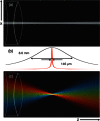Simultaneous spatial and temporal focusing for tissue ablation
- PMID: 23761847
- PMCID: PMC3675863
- DOI: 10.1364/BOE.4.000831
Simultaneous spatial and temporal focusing for tissue ablation
Abstract
Simultaneous spatial temporal focusing (SSTF) is used to deliver microjoule femtosecond pulses with low numerical aperture geometries (<0.05 NA) with characteristics that are significantly improved compared to standard focusing paradigms. Nonlinear effects that would normally result in focal plane shifts and focal spot distortion are mitigated when SSTF is employed. As a result, it is shown that SSTF will enable surgical implementations that are presently inhibited.
Keywords: (140.3390) Laser materials processing; (190.4360) Nonlinear optics, devices.
Figures











References
-
- Pronko P., Dutta S., Squier J., Rudd V., Du D., Mourou G., “Machining of submicron holes using a femtosecond laser at 800 nm,” Opt. Commun. 114(1-2), 106–110 (1995).10.1016/0030-4018(94)00585-I - DOI
-
- Juhasz T., Kastis G. A., Suárez C., Bor Z., Bron W. E., “Time-resolved observations of shock waves and cavitation bubbles generated by femtosecond laser pulses in corneal tissue and water,” Lasers Surg. Med. 19(1), 23–31 (1996).10.1002/(SICI)1096-9101(1996)19:1<23::AID-LSM4>3.0.CO;2-S - DOI - PubMed
-
- Juhasz T., Loesel F. H., Kurtz R. M., Horvath C., Bille J. F., Mourou G., “Corneal refractive surgery with femtosecond lasers,” IEEE J. Sel. Top. Quantum Electron. 5(4), 902–910 (1999).10.1109/2944.796309 - DOI
-
- Kurtz R. M., Horvath C., Liu H. H., Krueger R. R., Juhasz T., “Lamellar refractive surgery with scanned intrastromal picosecond and femtosecond laser pulses in animal eyes,” J. Refract. Surg. 14(5), 541–548 (1998). - PubMed
Grants and funding
LinkOut - more resources
Full Text Sources
Other Literature Sources
Research Materials
